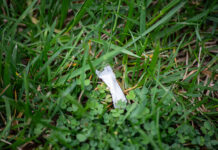There are many myths that surround the stink bug, like the smell can attract many more, and that they bite humans, but contrary to popular belief, brown marmorated stink bugs and their large population in the Slippery Rock area are nothing more than a smelly nuisance.
Dr. Jack R. Layne Jr., professor in the biology department, claims that to first understand stink bugs you have to understand the difference between an insect and a bug.
“Not all insects are bugs, but all bugs are insects,” Dr. Layne explained.
Insects are the broad group that contains many different genres of insects. Bugs are a specific group of insects that have a particular winged structure, and a tubular mouth that is used to draw up fluids into the mouth. Stink bugs are a specific type of bug that causes a nuisance to the campus population, Dr. Layne explained.
According to the Slippery Rock Pest Control website, there are two types of stink bugs that could be found in the Western Pa. area. The two species are the green stink bug that was originally from the area, and the brown marmorated stink bug that was initially brought over from Asia to Allentown, Pa. Between the two species, the brown marmorated stink bug has overpopulated, making it the most common stink bug seen, as compared to the rarely seen green stink bug.
“It is unclear how the brown stink bug came to America, but one option is that they could have came through a shipping container from Asia,” Dr. Layne said.
Stink bugs not only are a nuisance to homeowners and students around campus, but they can do quite a bit of damage. According to Penn State’s College of Agriculture website, stink bugs can do severe damage to crops, such as corn, apples, peaches, and other plants. The fruit, when eaten by stink bugs, become bruised and the crop looks distorted, causing the produce to be considered unmarketable.
Scientists are trying to figure out a way to control the population, but it is not the top priority compared to some other species in the area. The main problem is that the brown stink bug has few natural predators, because their smell does not make it easy for animals to consume, according to Dr. Layne.
David Trozzo, former SRU student and owner of Slippery Rock Pest Control, explained that mild winters and summers are when stink bugs reproduce the most, up to 400 eggs at a time per female, and winter is when they go into hibernation looking for warmth. Stink bugs, like most animals, have instincts and these insects are able to tell that winter is coming.
“They start coming inside [homes] because the days become shorter,” Trozzo said.
Trozzo said the insects can be found in door cracks, in the sides of windows, in the basement, and even the bathroom, but the difficult task is how to properly kill them.
“Stink bugs are very difficult to kill, due to their winged shield on their backs, because the insecticides bounce right off the shield,” he said, explaining that the spray needs to hit the insect on the abdomen for them to truly be affected by the insecticide.
The best thing to do with stink bugs is repel them before an infestation can start, according to Trozzo.
Around campus, especially in the dorm rooms, the way that stink bugs enter the building is mostly through opened windows. Trozzo advises that students try not to open windows that do no have a screen, and make sure that the screen does not have any holes.
Killing a stink bug is a different process than just smashing them with a shoe or book.
“Don’t crush the [stink bugs]. Catch them with a tissue, and flush them down the toilet,” Trozzo said. Crushing stink bugs releases an odor that is used as a protective mechanism against predators.
Stink bugs are going to be around for a long time, and it is best for students and faculty to properly learn how to handle the stink bug, until a way to control their population is established, according to Trozzo.







